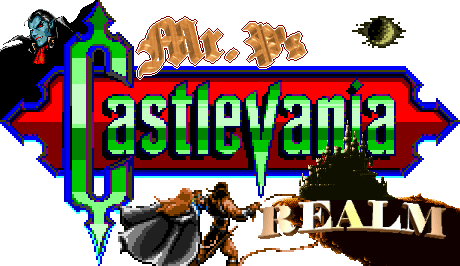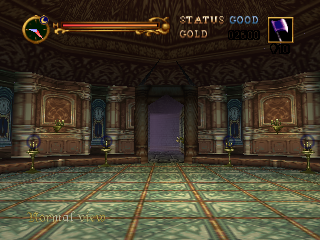
![]() Consistent Chaos
Consistent Chaos ![]()
Even though the familiar halls of Castlevania always remain a constant, the rest of the castle and its surroundings seem to differ greatly from game to game. However, there are those nostalgic instances where you'll find an area from one game intact in a sequel. The following three pages will be used to display the rare instances of consistency in the ever-changing, chaotic state of Castlevania.
The Clock Tower

![]()

| Castlevania: Symphony of the Night is a true sequel to Dracula X: Rondo of Blood in that it utilizes similar castle structures and the same sprites. The clock tower in both games shows this. In Rondo, the stage starts on a long, collapsing bridge, mutant bats hoarding the area, while Symphony has the same bridge area, with flail guards, phantom skulls and skull lords creating a similar obstacle. The three main towers of the clock area are the same, too, with harpies and/or Medusa Heads flying all around, and the gears that you can strike to open hidden doors are present in both games. |

![]()

| In both instances, the next long hallway has a maze of stairs where sword lords will block the narrow passageways. Even the designs on the pillars look the same--bricks that spiral around. And the breakable wall--obviously showing in the Rondo picture, above the sword lord--can also be broken in Symphony. In both games, the tower exit can be reached by utilizing two large swinging pendulums. |

![]()

| Finally, in both games, the last leg of this area has statues that point at walls that contain secrets. It looks as though the red brick wall collapsed between games, revealing more pointing statues right behind it. As you can see in the top-right corner of the top-right picture, the cross design on the wall resembles those found in the Rondo picture. |

![]()

| In Rondo, the next room holds Shaft's Ghost, while the same room in Symphony holds the Karasuman. |
![]()
![]()
![]()
The Town of Jova

![]()

| You'll recognize the town of Jova as the place you begin in Simon's Quest. The town itself is bustling with activity, and zombies walk the streets at night. Almost one hundred years later, in Rondo of Blood (where the town for some reason has swapped its name with Aljiba, which was actually another location in Simon's Quest), the town is completely destroyed in Dracula's wake, and Richter must cross through the fiery debris while ape skeletons continue blowing things up with their exploding barrels. Whereas Simon met many villagers, Richter will enter the town only to be greeted by a barrel-carrying ape skeleton. |

![]()

| Unlike in Simon's Quest, you can't enter any of the buildings (save for the alternate path), but you can still read the signs, and you can now whip the lanterns that hang outside each building. |

![]()

| You'll even pass by that same church where Simon once healed his wounds. Not even a place of worship is sacred when Dracula's forces are around, even though the man himself was at one time a Catholic in his living days. |

![]()

| Architecturally, the Transylvanian town has advanced greatly by the time of Rondo, as it now spreads out left and right, replacing the wolfmen-inhabited woods and the Jova marshland. |
![]()
![]()
![]()
The Twisting Towers

![]()

|
The normal route that the Belmonts have been forced to take to reach the courtyard involves plunging into the abyss near the tail-end of the chapel that empties into the catacombs. Over time, the abyss became two-sided, with a long tower on the opposite end to help you get back up into the upper levels after the long fall. This is most prevalent in the games shown above: In Castlevania 64/Legacy, the Cerebros-guarded courtyard that contains the Villa is right past the castle wall, which features two towers on either side. These very well could be those two abyss towers; this would mean that the switch mechanism room in the right tower rests directly below the tower of sorcery (the chapel). In Circle of the Moon, you fall into the abyss after Dracula blows open a hole in the Ceremonial Room (a sort-of place of worship) and wind up in the catacombs that lead to the courtyard for a fight with, you guessed it, the same enemy from 64's courtyard--Cerebros; and you can only get back up using the Abyss Stairway, the other tower. And there's a resemblance between the two games' towers: They each contain spiraling staircases, with multiple bone pillars and flying baddies that guard the way up. Of course, since Circle is 2D, you only see yourself walking upon the front-most steps. The similarity, as I've second-guessed, is far from a stretch since the same team, KCEK, worked on both games. |
![]()
![]()
![]()
Outer Ruins

![]()

|
The fourth stage in Castlevania will always be remembered infamously as the place where hunchback-carrying eagles made their debut. The upper portion of the stage is more or less the tail-end of the courtyard, which separates the two halves of the castle, that leads into the "Frankenstein" cave beneath the dungeon; in its background, we can only see the undisturbed woodland. Both Castlevania and Akumajou Dracula X68000 have this in common since theirs is the earliest look of this area. In the case of evolution, the shrubbery in the background of X68000 does indicate the forthcoming of the Villa and its hedge maze in Castlevania 64, and we do learn of a fountain that will eventually become the area's trademark. By the time of Symphony of the Night, it was Olrox who inherited the whole area as part of his quarters, and under his rule, it changed in two ways: (1) Buildings were added to the location where the hunchback-carrying eagles used to lurk (as seen in the top-right picture), one of which is the aforementioned Villa from Castlevania 64; and (2) the actual ruins were shelved off, pushed closer to the castle keep--the hunchback-carrying (or flea riders, as they may be) eagles with it. Clearly, now, the whole is centered around the Villa. Therein, Olrox himself may have been a past relative of the Oldreys, a family doomed to vampirism after Master Oldrey became seduced by evil and let Dracula's forces inhabit the place as a sort of halfway house. |

![]()

| By the time of Aria of Sorrow, the former ruins had been supernaturally crafted into an anomalous pathway, from where the entrance into the Chaotic Realm and the castle's sealed essence, could be camouflaged within. Upon entering the area, called the "Floating Garden," you'll notice the building in the background that could be the castle wall or possibly the very same Villa from games' past; you'll also notice the familiar fountain. As mentioned: The path is anomalous, so each room of the garden mysteriously branches off into map sections spread castle-wide. In one of the area's "floating" rooms close to the Castle Keep, you'll encounter altairs who transport and drop dagger-chucking rippers (the proverbial "eagles carrying hunchbacks" that was once a trademark of this area). While it doesn't make much sense structure-wise, it can help us explain why Symphony's eagle-carrying-hunchback room is so far away from the fountain: What we were viewing while playing the game is the early stage of the breaking apart of the ruins in its supernatural transformation into the Floating Garden. |

![]()

![]()
![]()
![]()
Shaft's Holding Room

![]()

| In his Rondo of Blood adventure, Richter locates Maria in a sealed off chamber at the tail-end of the fishmen-inhabited room right below the main hall. Richter unlocks the door using a key he found in the main hall while fleeing from the raging bull, only to find a single-torch-lit room where Shaft is holding her within an ambient blaze that'll soon banish her into a netherworld of eternal suffering. Shaft flees at the sight of the hero, and Maria is saved. Four years later, when Alucard returns to the castle (as does Richter) in Symphony, he can find the same room in exactly the same location, however small it may may look from his vantage point. And it's once again blocked off, this time by a stone barrier--but there's no key in the main halls to be found. Rather, you'll eventually lower the barrier by hitting a switch when you enter into the room from the other side via the Underground Cavern. |
![]()
![]()
![]()
Room of Clocks

![]()

| It was in Symphony of the Night's huge Marble Gallery where the Room of Clocks was first encountered by Alucard. Fifty years earlier, Juste discovered the same room in the lower portion of the clock tower, which perhaps served as its main entryway. The location of the room in both games is similar, but in Symphony, it appears that the last room of the Marble Gallery and the whole Outer Wall section winds up replacing a leg of the clock tower. Despite their placement, the design detail is as close as the games' artists could get it. When Cornell and later Reinhardt and Carrie ventured through the castle, they passed into the same room from the rightmost towers, it directly preceding the clock tower as it had in Harmony. If you envision Symphony and Harmony's clock rooms as rounded, as in three-dimensional, you can envision the N64 clock room much better. |
 |
|
 |
![]()
![]()
![]()
Pendulum Swing

![]()

| There are many instances, within that ever-changing clock tower, of swinging pendulums, but there are certain times throughout the series where you'll come to a long gap that can only be traveled over using a set of two (and usually three) pendulums. The first instace you'll remember is Dracula's Curse's: While avoiding Medusa Heads, you had to jump from pendulum to pendulum in order to escape to the castle keep. As a nod to this sequence, the creators of Rondo patterned their clock tower to match it; the placement is about identical, with only a short hall thereafter connecting to the keep. We've already learned of the similarities of this tower and Symphony's, so this pendulum instance exists here all the same. |

![]()

| Finally, while not the conventional placement, future developers have played off of this level design even if not duplicating it; that is, similar sets of pendulums appear in Harmony of Dissonance, Aria of Sorrow and Dawn of Sorrow. Harmony's instance is not indicative, since the clock tower's positioning is off, but Aria and Dawn of Sorrow's can be considered a relatively close match, because the keep isn't that far off from either position. |

Page 2: Even More Similarities
|
[Home] [What's New?] [CV Library] [Stages] [Reviews] [Weapons] [Castleography] [Multimedia] [Codes] [Links] |
||||
